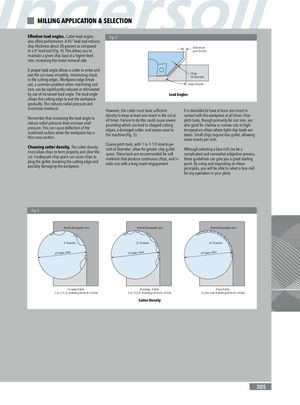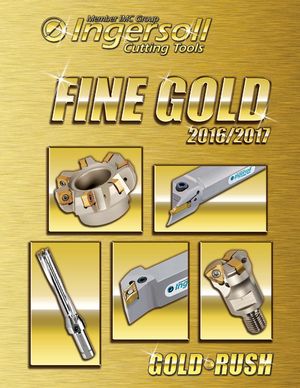Общий каталог Ingersoll 2011 - страница 303
Навигация
- 0003 Table of Contents
- 0006 End Mills
- 0064 Long Edge
- 0104 0Deg Face Mills
- 0160 Face Mills
- 0202 Slotters
- 0218 Form Mills
- 0236 Profile Mills
- 0302 Milling Tech
- 0384 Solid Carbide
- 0448 Solid Carbide Tech
- 0474 Holemaking & Thread Milling
- 0666 Holemaking & Thread Milling Tech
- 0720 Innofit Top On Toolholders
- 0738 HSK Toolholders
- 0774 CAT Toolholders
- 0796 BT Toolholders
- 0816 Adaptions Accessories
- 0872 Turning Inserts
- 1024 Turning Holders
- 1144 Turning Tech
- 1174 Threading Inserts
- 1242 Threading Holders
- 1256 Threading Tech
- 1268 T-Clamp
- 1344 T-Clamp Tech
- 1376 T-CAP
- 1388 T-CAP Tech
- 1394 Product_Index

MILLING APPLICATION & SELECTION Effective lead angles. Cutter lead angles Fig. 4 also affect performance. A 45° lead tool reduces chip thickness about 30 percent as compared Advance to a 0° lead tool (Fig. 4). This allows you to per Tooth maintain a given chip load at a higher feed rate, increasing the metal removal rate. A proper lead angle allows a cutter to enter and exit the cut more smoothly, minimizing shock ChipThickness to the cutting edges. Workpiece edge break- out, a common problem when machining cast Lead Angle iron, can be significantly reduced or eliminated by use of increased lead angle. The lead angle Lead Angles allows the cutting edge to exit the workpiece gradually. This reduces radial pressure and minimizes breakout. However, the cutter must have sufficient It is desirable to have at least one insert in Remember that increasing the lead angle toreduce radial pressure does increase axialpressure. This can cause deflection of themachined surface when the workpiece has athin cross-section.density to keep at least one insert in the cut atcontact with the workpiece at all times. Fineall times. Failure to do this could cause severepitch tools, though primarily for cast iron, arepounding which can lead to chipped cuttingalso good for shallow or narrow cuts in high-edges, a damaged cutter, and excess wear totemperature alloys where light chip loads arethe machine (Fig. 5).taken. Small chips require less gullet, allowingmore inserts per inch. Choosing cutter density. The cutter densitymust allow chips to form properly and clear thecut. Inadequate chip space can cause chips toplug the gullet, breaking the cutting edge andpossibly damaging the workpiece.Coarse pitch tools, with 1 to 1-1/2 inserts perinch of diameter, allow for greater chip gulletspace. These tools are recommended for softmaterials that produce continuous chips, and inwide cuts with a long insert engagement.Although selecting a face mill can be acomplicated and somewhat subjective process,these guidelines can give you a good startingpoint. By using and expanding on theseprinciples, you will be able to select a face mill for any operation in your plant. Fig. 5 Insert Engagement Insert Engagement Insert Engagement 6 Inserts 12 Inserts 20 Inserts 4" diameter 4" diameter 4" diameter Coarse Pitch Medium Pitch Fine Pitch 1 to 1-1/2 inserts per inch of dia. 2 to 3-1/2 inserts per inch of dia. 4 or more inserts per inch of dia. Cutter Density 305
 Общий каталог Ingersoll 2016 - 2017
Общий каталог Ingersoll 2016 - 2017 Общий каталог Ingersoll 2014
Общий каталог Ingersoll 2014 Каталог Ingersoll инструмент для нарезания резьбы
Каталог Ingersoll инструмент для нарезания резьбы Общий каталог Ingersoll 2013 - 2014
Общий каталог Ingersoll 2013 - 2014 Каталог Ingersoll новинки 2021
Каталог Ingersoll новинки 2021